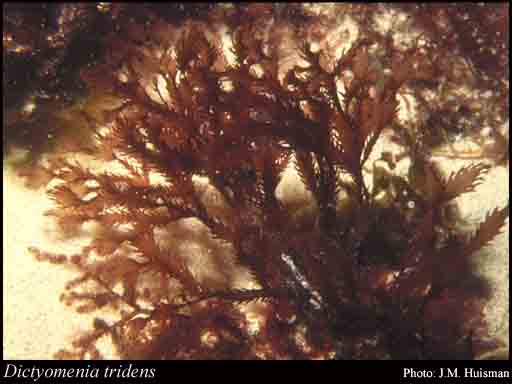- Reference
- Algae Brit. li (1830)
- Conservation Code
- Not threatened
- Naturalised Status
- Native to Western Australia
- Name Status
- Current

Scientific Description
Habit and structure. Thallus dark brown-red, erect, 10–40 cm high, complanately and irregularly marginally branched, with flat indeterminate branches 2–3 mm broad, above with a central midrib and reticulate surface pattern, bearing marginally short determinate branches 1–2 mm long, alternately positioned 1–3 mm apart, each with a broader base and tapering to 2–3 slender upper branches. Indeterminate lateral branches develop by continued growth of determinate laterals. Older indeterminate branches become denuded of the wings and the midrib thickened. Holdfast fibrous, 5–20 mm across, with terete branches; epilithic. Structure. Apical cell dome-shaped, 8–18 µm in diameter, segmenting transversely, with determinate laterals (2–)3–4 cells apart, axial cells remaining conspicuous throughout the thallus. Indeterminate branches with 6 pericentral cells, 2 large lateral ones and 2 smaller ones on each surface, with the large lateral pericentral cells dividing laterally to form the flat branch and becoming corticated early between the pericentral cells and their derivatives (i.e. over the wings), more so over the midrib, especially below. Determinate laterals of clusters terete, with 5(–6) pericentral cells, corticated. Trichoblasts occur near apices of determinate branches but readily caducous, branched, 1–2 mm long, basal and mid cells 20–30 µm in diameter and L/D (1–)2–3. Cells uninucleate; rhodoplasts discoid.
Reproduction. Reproductive organs borne on branch clusters arising above lateral veins on the surface of main branches or as continued development of determinate laterals near apices. Gametophytes dioecious. Procarps not observed. Carposporophytes with a small basal fusion cell and short, branched, gonimoblast filaments bearing elongate-clavate terminal carposporangia 30–55 µm in diameter. Cystocarps ovoid to slightly urceolate, 800–1200 µm in diameter; pericarp ostiolate, corticated on mid and lower parts. Spermatangial organs ovoid to elongate, 90–140 µm in diameter and 140–350 µm long, with 1–2 sterile basal cells and a uniseriate sterile apex 5–7 cells and 180–350 µm long. Tetrasporangia in the branched clusters on branch surface, branches terete, 180–230 µm in diameter, with segments L/D 0.5–1. Tetrasporangia in short series, one per segment, spirally arranged, 140–200 µm in diameter, with 2 cover cells.
Distribution.Houtman Abrolhos, W. Aust., to San Remo, Vic., Deal I., Bass Strait, and Twofold Bay, N.S.W.; doubtfully further north.
Habitat. D. tridens is a deep-water alga on rough-water coasts along most of southern Australia.
[After Womersley, Mar. Benthic Fl. Southern Australia IIID: 344–345 (2003)]
Distribution
- IBRA Regions
- Swan Coastal Plain.
- IBRA Subregions
- Perth.
- IMCRA Regions
- Abrolhos Islands, Central West Coast, Leeuwin-Naturaliste.
- Local Government Areas (LGAs)
- Augusta Margaret River, Cockburn, Coorow, Dandaragan, Greater Geraldton, Irwin, Joondalup, Mandurah, Rockingham, Wanneroo.